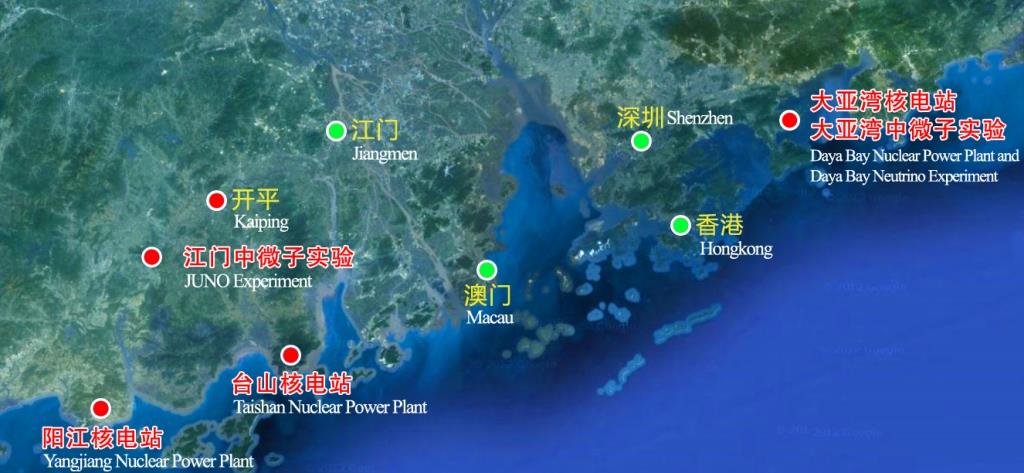Groundbreaking at JUNO
On January 10, the groundbreaking ceremony for the Jiangmen Underground Neutrino Observatory (JUNO) was held in Jiangmen City, Guangdong Province, China. More than 300 scientists and officials from China and other countries attended the ceremony and witnessed this historical moment.
JUNO is the second China-based neutrino project, following the Daya Bay Reactor experiment, and is designed to determine the neutrino mass hierarchy via precision measurements of the reactor neutrino energy spectrum. The experiment is scheduled to start data-taking in 2020, and is expected to operate for at least 20 years. The neutrino detector, which is the experiment’s core component, will be the world’s largest and highest precision liquid scintillator detector.
After the determination of Θ13 by the Daya Bay and other experiments, the next challenge to the international neutrino community is to determine the neutrino mass hierarchy. Sensitivity analysis shows that the preferred range for the experiment stations must be 50-55 km away from a nuclear reactor.
Jinji Town, located in Kaiping, Jiangmen City, Guangdong Province, was chosen to be the experiment site for JUNO experiment. The site is 53 km from both Yangjiang and Taishan Nuclear Power Plants (NPP), with six 2.9 GW reactors at Yangjiang NPP and four 4.6 GW reactors at Taishan NPP, giving a total thermal power of 35.8 GW. By 2020, the effective power will be the highest in the world. The experiment hall will be located 729 meters underground.

Location of JUNO Experiment (Image by IHEP)
The JUNO experiment is in the spotlight of the world scientific community for its experimental significance and unique design. On July 28, 2014, the JUNO international collaboration was established. Over 300 scientists from 45 institutions in nine countries and regions have joined the Collaboration, and over ten institutions from five countries are planning to join the Collaboration.
Prof. WANG Yifang, JUNO Collaboration Spokesperson and Director of the Institute of High Energy Physics explained that at present, seven other experiments from five different countries and regions - Japan, Europe, the USA, India and Korea - are focusing on the determination of the neutrino mass hierarchy.
He is, however, confident of JUNO’s leading role in the field. “With leading liquid scintillator detector technologies, rich experience in reactor neutrino experiment, and innovative experiment design, the JUNO experiment could be the first to determine the neutrino mass hierarchy.” commented Prof. WANG.
Neutrinos are elementary particles, and are very difficult to detect. Based on particle physics experiments, matter consists of twelve fundamental particles, including three types of neutrino. They have no electrical charge and have a very small mass (less than one millionth of the mass of the electron), and their speed is nearly equal to the speed of light. Since neutrinos have very little interaction with matter, their detection is very difficult. Of all the fundamental particles, people know least about neutrinos.
The JUNO experiment aims to determine the neutrino mass hierarchy, a hot topic in international neutrino research. The neutrino mass hierarchy is very important in the evolution of the universe and in the probability of neutrino oscillations. It is also the basis for determining the absolute neutrino mass, and helps the neutrinoless double beta decay experiments. Neutrinos are a probe for studying celestial bodies as well as the Earth's interior, thus will play a key role not only in testing supernova burst mechanisms, but also in verifying geophysical models and studying other aspects of solar physics and geophysics. JUNO should be able to measure 3 out of the 6 neutrino mixing parameters to better than 1% precision, as well as studying supernova neutrinos, solar neutrinos, geo-neutrinos, atmospheric neutrinos and sterile neutrinos.
Delegations from the Chinese Academy of Sciences, the Ministry of Science and Technology of the People’s Republic of China, the National Natural Science Foundation of China and the Italian National Institute for Nuclear Physics (INFN) were present at the ceremony.
Media Contacts:
Yifang WANG
Spokesperson
IHEP
+86-10-88236076
Gioacchino Ranucci
Deputy Spokesperson
INFN-Milano
+39-0250317362
Jun CAO
Deputy Spokesperson
IHEP
+86-10-88235808
Lijun GUO
IHEP Public Affairs
+86-10-88235014